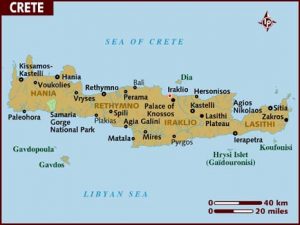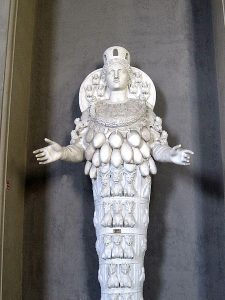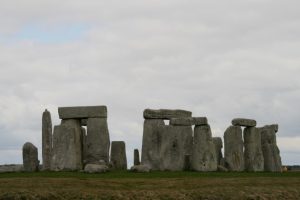Labyrinths – intricate structures of interconnecting passages through which it is difficult to find one’s way – have become popular focal points in the spiritual quests of people from many religious and non-religious persuasions. Labyrinths made of hedges outdoors or painted or etched on floors of churches can be found in more than 80 different countries around the world. In Christian settings, the labyrinth is often likened to a pilgrimage to Jerusalem, but the earliest labyrinths had their origins in a much earlier time, a time when people worshipped a female deity. Rediscovering the goddess-centered roots of the labyrinth deepens and broadens our understanding not only of the labyrinth itself but of the Christian faith as well. 
Labyrinths and caves are inextricably linked. From the study of Paleolithic-era caves, we know that human beings used these dark spaces to commune with the deepest, most resonant and awesome powers. According to Sjöö and Mor, Great Cosmic Mother (page 73), the paintings that have been found on cave walls in France and elsewhere “could be reached only with great difficulty, along winding paths, narrow ledges, slippery and dangerous passages. . .” so creating the paintings and viewing them were not casual, everyday experiences. Rather, the paths leading to them “were the narrow winding passageways of birth, and rebirth.” The paintings were expressions of deep, vitally important experiences and may have been created by shamans or other religious leaders who were in touch with sublime truths and revelations.
Pre-industrial peoples viewed the very earth as “mother.” A cave represented the womb of this mother – dark, mysterious, life-giving, and the repository of mystic influences. To be fully in touch and united with the goddess, indeed with oneself, one had to dance or walk the labyrinth – to travel through the mother goddess to one’s real, ultimate self. As pointed out by famed mythologist Joseph Campbell, the tomb-cave is built to resemble the womb so that the initiate becomes reborn by following the spiral to the all-important center point (Primitive, 69).
To prehistoric and other pre-industrial peoples, it would have been extremely important to be initiated in this way once in one’s lifetime: it was a matter of life and death. It was a quest for integration of the individual soul with a higher energy force, perceived as the self, eternal spirit, the earth, and the goddess all at once. “The ecstatic center of the labyrinth was the no-mind center of orgasm experienced as death, creative madness, and the loss of the conditioned ‘self’” (Sjöö and Mor, Great Cosmic Mother, 73-75). The cave evoked the latent energies of the “unfathomed human heart,” the Paleolithic temple-caves perhaps being “the first manifestations of the fact that there is a readiness in man’s [sic] heart for the supernormal image. . . [W]hen the sense of time and space was gone, the visionary journey of the seer began” (Campbell, Primitive, 397).
The initiation rites in and around the labyrinth were very powerful and memorable, made even more so by energy and related natural phenomena in the caves themselves. A series of experiments conducted in Neolithic monuments in Great Britain illustrated some of these phenomena, especially those having to do with sound (see Watson, “Sounds,” 88-89). “Standing waves” of sound can be produced in passage graves by combining two sound waves of equal frequency and intensity traveling in opposite directions. When a group of people chanted in one of these spaces, the volume and intensity of the sound became so enhanced that it was difficult to determine its source. Even more disconcerting were “the disquieting feeling that some sounds were emerging from inside the head and body of the listener” and that the sound became “louder as the listener moved away from the source, or fluctuated as others moved around the chamber.”
These same researchers also demonstrated a phenomenon at certain Neolithic monuments. The Helmholtz Resonance is created when sound waves generated in the burial or other chamber make the air expand and contract repeatedly. The phenomenon can only occur when a sound is at a certain pitch, which the researchers calculated in one passage grave as about 2 hertz, a sound so low that the human ear does not hear it; rather, the notes are felt as a physical or psychological sensation. In prehistory, such a sound was created by drumming, probably at two beats per second. When the recent experiments were conducted, “volunteers reported dizziness, sensations of ascent, and the feeling that their breathing and pulse were affected. In the research literature, there are accounts of vibration, balance disturbance, headaches, and even altered states of consciousness caused by similar sounds. For people in prehistory, it is easy to imagine that such sensations seemed to originate in the supernatural realm” (Watson, “Spirit World,” 90-91), making the entire cave experience memorable, if not life-altering.
In many cultures, labyrinths were presided over by a mythical woman, which makes sense if the cave is equated with the womb. Relatedly, ancients saw the earth as alive, with a life-spirit of energy connected to the very core of the planet and to the stars, the moon and the sun. The earth force, like a magnetic current, is emitted by underground waters. This force causes wave-motions perpendicular to the earth’s surface, forming spiral patterns, mazes and labyrinths. Lines formed by this motion remain constant over time and are utilized by birds and animals. Ancient peoples knew about this phenomenon and also tapped into it, positioning sacred monuments and pathways on or near them. Spots in the earth that are particularly affected by or in tune with these energy forces were known to foster social and personal harmony, bring about healing, ease labor pains, and enable communication with the divine (see Sjöö and Mor, Great Cosmic Mother, 124-28).
Given all these connections and associations, it is no surprise that signs and symbols linking women, caves, the womb, ecstasy, the labyrinth, life and integration are numerous in finds from the Paleolithic and Neolithic eras in Old Europe, the Middle East and the Mediterranean. Some of these symbols include spirals, snakes, swastikas, labrys (double triangle), square, wavy lines, zigzag lines, and chevrons, and they appear in a wide array of combinations on goddess figurines, paintings, pottery, funerary objects, and so on. By looking at these objects, we can begin to understand their meaning is life, joy, harmony with Nature and between human beings, and abundance. It is apparent that these people were deeply in touch with everything around and in them, and the labyrinth ritual was a part of that.
Some Pre-Christian Labyrinths in the West
Vincent Scully, Sterling Professor Emeritus of the History of Art in Architecture at Yale University, discussed in his comprehensive volume, The Earth, the Temple and the Gods, labyrinths at several significant ancient sites.
 Crete. The sanctuary at Knossos on the Greek island of Crete is one of the most important labyrinths in the Western world. The so-called Palace of Knossos is designed in the form of a vast labyrinth, at which significant processions and rituals, including the well-known bull dance, would have been held during the Minoan era. Mount Jouctas, which was seen as “horned,” was visible nearby, and the goddess’ cave shrine was on it. The entranceway to the Palace is directly on the mountain’s axis. After passing through this propylaia and mounting stairs, initiates would be led downward to the east and into the bright light of the court. It is here that the bull dance took place – a beautiful, powerful ritual in which young men and girls seized the horns sacred to the goddess and leaped, propelled by the power of the horns. While the bull may have been sacrificed to the goddess later, there was apparently no blood shed in a violent way. The dance “did not dramatize subtle man making his own shapes around and finally killing the unreasoning power of nature but instead celebrated both men and women together as accepting nature’s law, adoring it, adding to their own power precisely insofar as they seized it close and adjusted their rhythms to its force” (Scully, 12-13). The procession continued, alternating between darkness and light. The space is fluid and moving, and water ran through the cave. The ritual culminated in the innermost cavern shrine.
Crete. The sanctuary at Knossos on the Greek island of Crete is one of the most important labyrinths in the Western world. The so-called Palace of Knossos is designed in the form of a vast labyrinth, at which significant processions and rituals, including the well-known bull dance, would have been held during the Minoan era. Mount Jouctas, which was seen as “horned,” was visible nearby, and the goddess’ cave shrine was on it. The entranceway to the Palace is directly on the mountain’s axis. After passing through this propylaia and mounting stairs, initiates would be led downward to the east and into the bright light of the court. It is here that the bull dance took place – a beautiful, powerful ritual in which young men and girls seized the horns sacred to the goddess and leaped, propelled by the power of the horns. While the bull may have been sacrificed to the goddess later, there was apparently no blood shed in a violent way. The dance “did not dramatize subtle man making his own shapes around and finally killing the unreasoning power of nature but instead celebrated both men and women together as accepting nature’s law, adoring it, adding to their own power precisely insofar as they seized it close and adjusted their rhythms to its force” (Scully, 12-13). The procession continued, alternating between darkness and light. The space is fluid and moving, and water ran through the cave. The ritual culminated in the innermost cavern shrine.
Eleusis. Eleusis is a sanctuary not far from Athens dedicated to the goddesses Demeter and Persephone. According to Scully (75-76), the Eleusinian sanctuary represents a passage between worlds, celebrated in the Odyssey and by Virgil and is “at the end of a tortuous labyrinth. . . . Having come first to the cave of death, the [Sacred] Way passes beyond it and curves snakelike upward to the left around the side of the hill. One can imagine the path of the [procession’s] torches, a sinuous trail of fire, as they approached the great hollow bulk of the Telesterion,” the main building that represented the conclusion of the Way. It was here that initiates learned the ultimate mystery of the rite – and indeed of life.
Ephesos. Another ancient labyrinth locale is the temple of Artemis at Ephesos in Turkey.  It was this powerful goddess whom St. Paul ostensibly confronted in Acts 19 – with little success. The huge colonnade of this gigantic temple – the largest temple built in antiquity – was for all intents and purposes a “forest through which the labyrinthine processions wound” (Scully, 90-91). Devotees would have moved “in a ceremonial dance, a dance winding and sinuous until it was pulled. . . toward the cella [central temple area] itself. Finally, the doors, on their special days, would have directed the labyrinth into, and perhaps through, the hidden space where the image [of Artemis] stood on the axis between Asia and the sea.”
It was this powerful goddess whom St. Paul ostensibly confronted in Acts 19 – with little success. The huge colonnade of this gigantic temple – the largest temple built in antiquity – was for all intents and purposes a “forest through which the labyrinthine processions wound” (Scully, 90-91). Devotees would have moved “in a ceremonial dance, a dance winding and sinuous until it was pulled. . . toward the cella [central temple area] itself. Finally, the doors, on their special days, would have directed the labyrinth into, and perhaps through, the hidden space where the image [of Artemis] stood on the axis between Asia and the sea.”
 Great Britain. Contemporaneous with the sanctuaries at Crete are the stone-circle structures we know as Stonehenge, Avebury, Woodhenge and others. These structures also strongly suggest the labyrinth and its rites and purposes (Scully, 22-23).
Great Britain. Contemporaneous with the sanctuaries at Crete are the stone-circle structures we know as Stonehenge, Avebury, Woodhenge and others. These structures also strongly suggest the labyrinth and its rites and purposes (Scully, 22-23).
Resources
Campbell, Joseph. The Masks of God: Primitive Mythology. New York: Penguin Books, 1982; first ed., Viking Press, 1959.
Scully, Vincent. The Earth, the Temple and the Gods, revised ed. New Haven and London: Yale University Press, 1979; first printed 1962.
Sjöö, Monica, and Barbara Mor. The Great Cosmic Mother. San Francisco: Harper & Row, Publishers, 1987.
Watson, Aaron. “Sounds of the Spirit World,” Scientific American Discovering Archaeology (January/February 2000) 88-89.
